
Search
The Renewable Energy site for Do-It-Yourselfers
ProMaster Camper Van Conversion -- Installing the Propane System
| |
Important Update
The material on these pages describing our camper van conversion has been moved to our new new site dedicated to efficient RVs and camper vans.
The new site covers all the material here and adds a lot of new material on other camper van conversions, camper van design and build, resources for people converting vans, other efficient camping vehicles, new ideas in efficient RVs and camper van travel hints.
The new site is here...
I'm leaving these pages here as you may have bookmarked them and the Comments section has some good suggestions, but I suggest that you go to the new site -- I won't be updating this material anymore.
Thanks to all the people who read these pages and especially to the people who left comments and suggestions! Feedback on the new site is very much appreciated.
Gary
|
|
Propane Tank Type and Location
We had a commercial van conversion RV some time back that had the propane tank mounted under the van. While this setup was OK, it did have some disadvantages: 1) the tank was always dirty from the road and tire splatter and all this dirt and mud made for a short life for the components like valves, gauges, and regulators, 2) the tank was one of the low points on the van and it seemed like it could be damaged, especially on back roads 3) the tank was difficult for the propane guys to fill due to its location and dirt, and 4) you had to find a place that refills cylinders and wait for them to find someone with the time to do the refill.
On this conversion, we decided on using a standard 5 gallon refillable cylinder (e.g. a standard BBQ cylinder) and to locate it in a sealed compartment within the van that is vented to the outside.
On the plus side, this arrangement 1) keeps the entire propane system out of the weather and mud, 2) allows you to either refill the cylinder or just trade it for a new cylinder at one of the many places that offers this service, and 3) its much cheaper than using one of the under van tanks.
On the negative side, 1) it takes up some space inside the van, 2) the capacity is only 5 gallons as compared to (typically) 8 gallons for the under frame tanks, and 3) some may feel there is a safety issue with having propane inside the van (see below).
M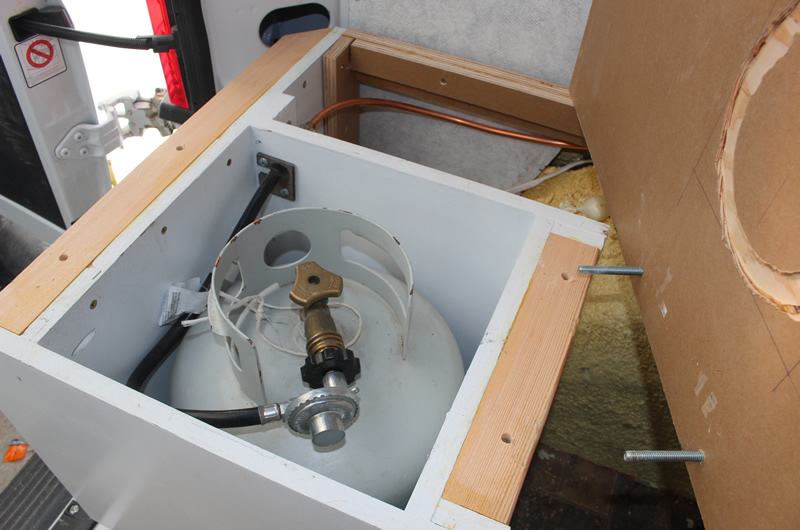
My guess is that the five gallon capacity will work out to be fine. For warm weather trips with little furnace use, the propane usage for just the stove will be small and the tank should easily last several trips. For cold weather trips, the van is small and pretty well insulated -- I believe (based on a little testing) that the propane usage per night at 32F will be about half a gallon, so the change tank interval should be at least a week. If you are doing the Dempster Highway in the middle of winter, you might want to carry an extra cylinder.
There are some potential safety issues both plus and minus to this arrangement. On the plus side, 1) the tank is protected from physical damage, 2) the propane compartment is strong, securely attached to the van, vented to the outside, and separated from ignition sources, 3) the whole propane system is inside and not subject to malfunction caused by dirt/mud/debris.
On the negative side, you have the propane tank inside the van. All stuff for YOU to consider, research and make up your own mind about.
There will, of course, be propane and CO alarm system to detect any leaks and incomplete combustion -- as there must be with any vehicle that uses propane (or any fuel).
| |
Some Information on 5 Gallon Propane Tanks
The 5 gallon or 20 lb propane tanks are very widely used -- mostly to power gas barbecues, but also for many other things like cooking, heating, weed burning, ...
They can be refilled at places that sell propane or there are many exchange services (e.g. Blue Rhino) that will exchange your empty tank for a full tank.
While the tanks have a nominal capacity of 20 lbs of propane, the overfill protection (OPD) float and valve limit the capacity to 17 lbs. And, many of the exchange services (e.g. Blue Rhino) only fill the tanks to 15 lbs. Propane weighs 4.2 lbs per gallon, so 15 lbs is 3.6 gallons -- if you get a full 17 lb fill, that's 4 gallons. The tanks are only filled to 4 gallons max so that there is always a gas space above the liquid propane to allow for expansion if the tank is subjected to a hot environment.
A gallon of propane has a heating capacity of about 92,000 BTU, so a full tank gives you about 330,000 to 370,000 BTU total.
The empty weight of each tank is stamped on the collar of the tank -- usually about 17 lbs. If you have something like a 50 lb fish scale, you can weigh the tank to get an idea how much propane is left. The tanks start at about 32 to 34 lbs full, and go down in weight as the propane is used. When the total tank weight is down to about 17 lbs, you are about out.
On the safety front: the tanks have overfill protection that prevents filling to more than 17 lbs of propane so that there is always a gas space above the liquid to limit the pressure inside the tank if the tank should be moved to a hot environment; there is a pressure relief valve in the tanks that blows out releasing the propane if the pressure inside the tank reaches a very high pressure; there are controls on the manufacturing of the tanks, and they have to be recertified after 10 years; there is a safety control in the tank valve that turns off the flow of propane if the flow exceeds a certain value (e.g. from a broken line). All this is good, but propane is dangerous and you should treat it with the utmost respect, and have a propane and CO alarm in your RV.
One caution about the Blue Rhino tanks -- some of them can only be refilled by Blue Rhino... This could be a big inconenience if you take your RV to a place where a Blue Rhino exchange is not available.
|
Installing the Propane System
The propane storage compartment is built into the aft end of the driver side bed unit. It is made with 3/4 inch high strength Medium Density Overlay (MDO) plywood and is bolted down through the floor in several places with 3/8 inch steel bolts.
The compartment is made so that the cylinder just fits inside of it, so there is no need to fasten the cylinder to the compartment as there is no place for it to go -- this makes it easy to do swap outs when the cylinder is empty.
The lid of the compartment is easily removable so that the propane cylinder can be removed for refilling or swapping out with a new cylinder. The lid is 3/4 MDO and is secured in place with 4 carriage bolts with wing nuts and washers on the bottom side -- takes about a minute to remove the lid and get the cylinder out.
The tank is a regular BBQ cylinder and the gas connection can be disconnected or connected by hand without tools.
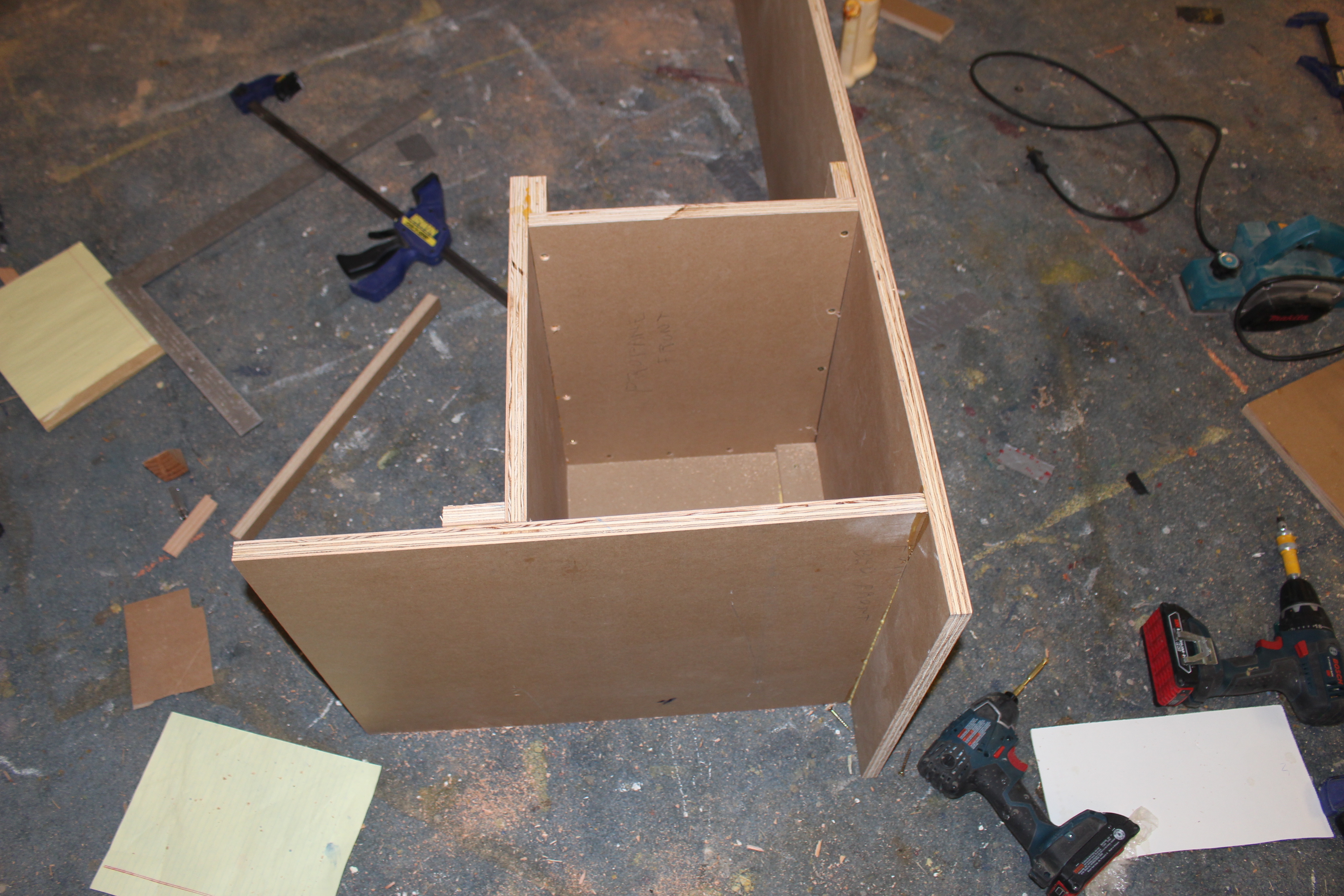
The propane compartment being built as part of the driver side bed support.
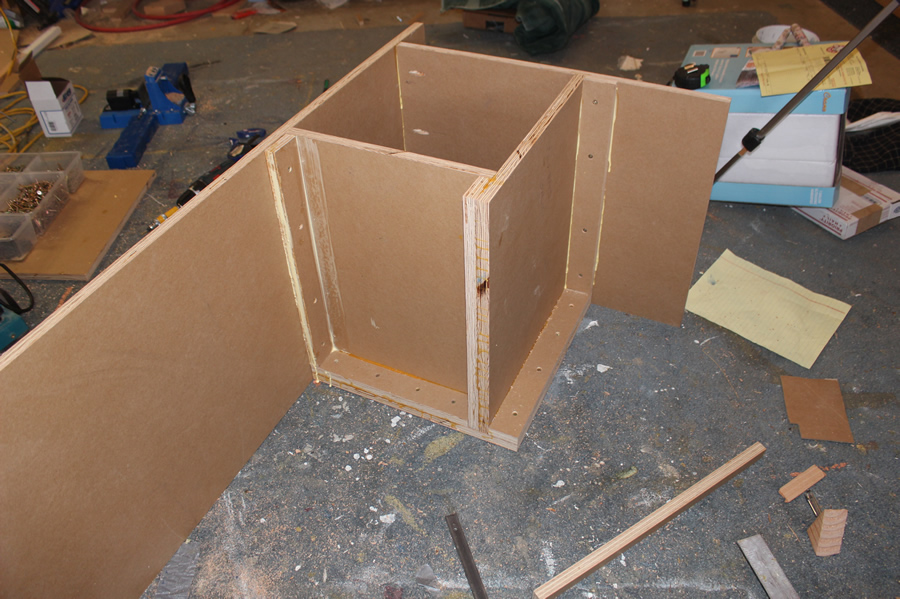
From the other side.
This is all glued and screwed together and then bolted down through the van floor in several places.
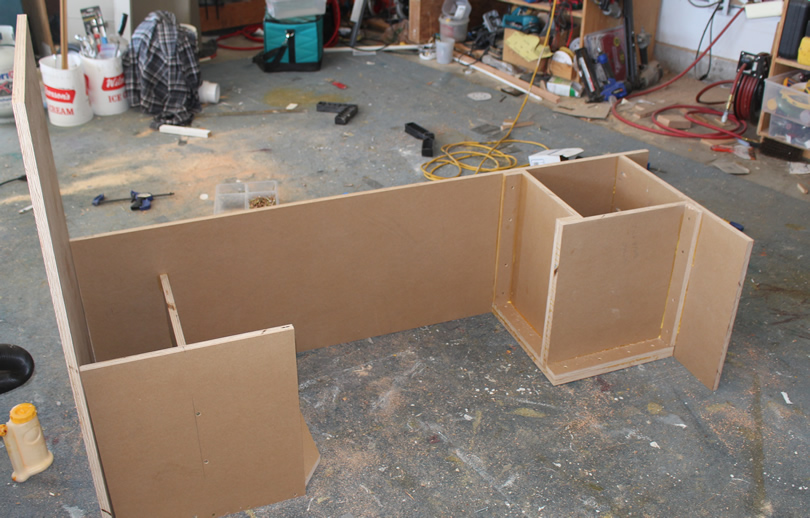
Another view of driver side bed platform -- propane compartment on right, battery compartment on left.
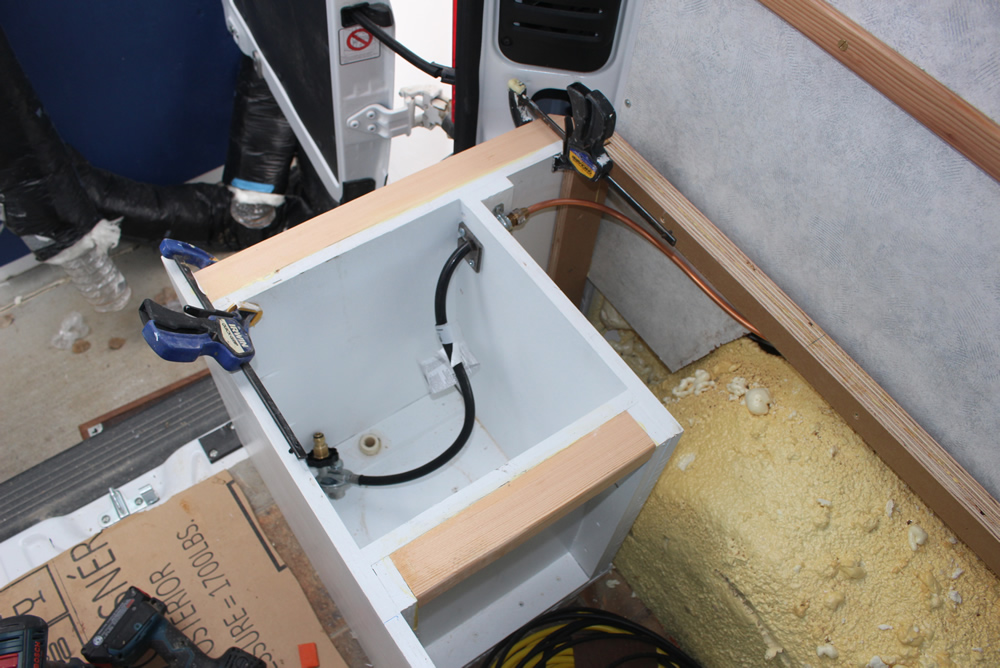
Mounted in the van. The 2 by blocks being glued and screwed in place provide a place secure anchor for the carriage bolts that hold the lid down.

Showing the compartment lid and the 4 bolts that hold it in place.
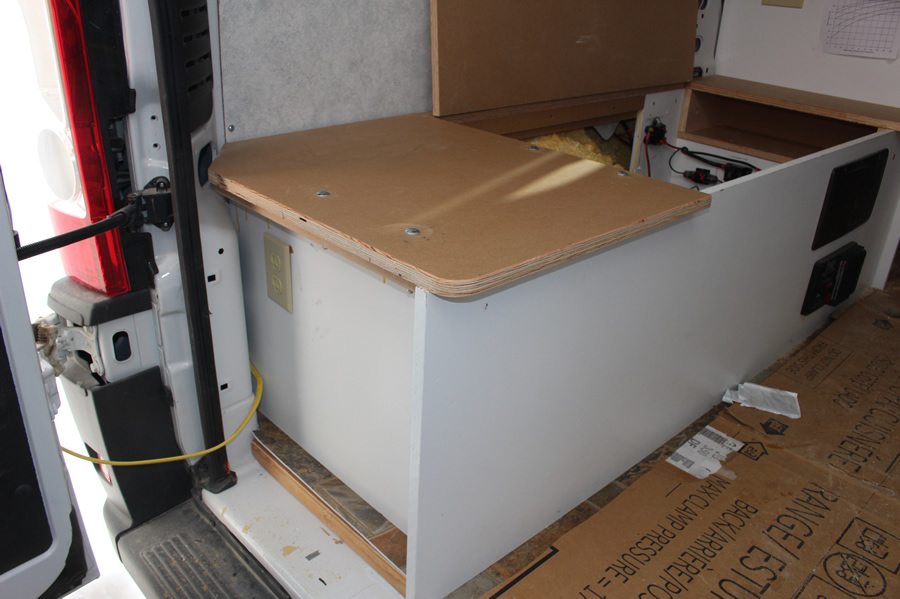
Lid secured in place with four wing nuts (for quick removal).
Venting the propane compartment
The compartment is vented with a 3/4 inch plastic line that goes from the bottom of the compartment straight down through the floor and is open at the bottom.
Make sure you are not drilling through something important!
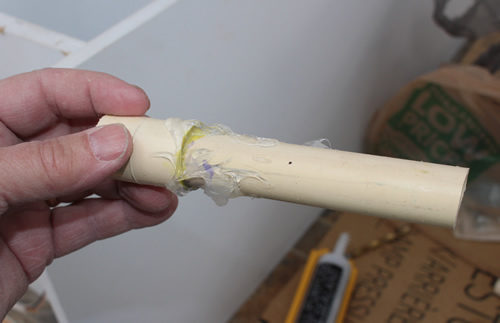
The vent tube that goes down through the floor. A coupling is installed on the top so that the tube can't slip down through the hole. Silicone seal is used to seal and glue it in place. |
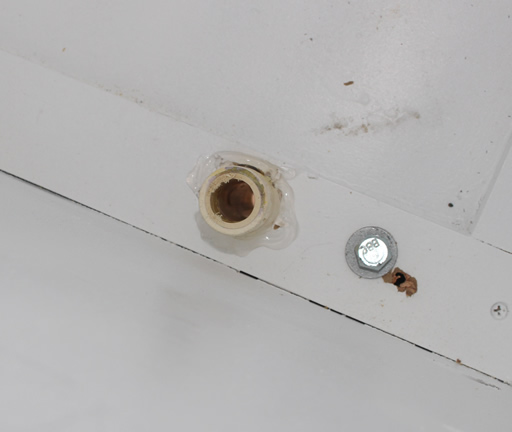
Vent tube installed in propane compartment |
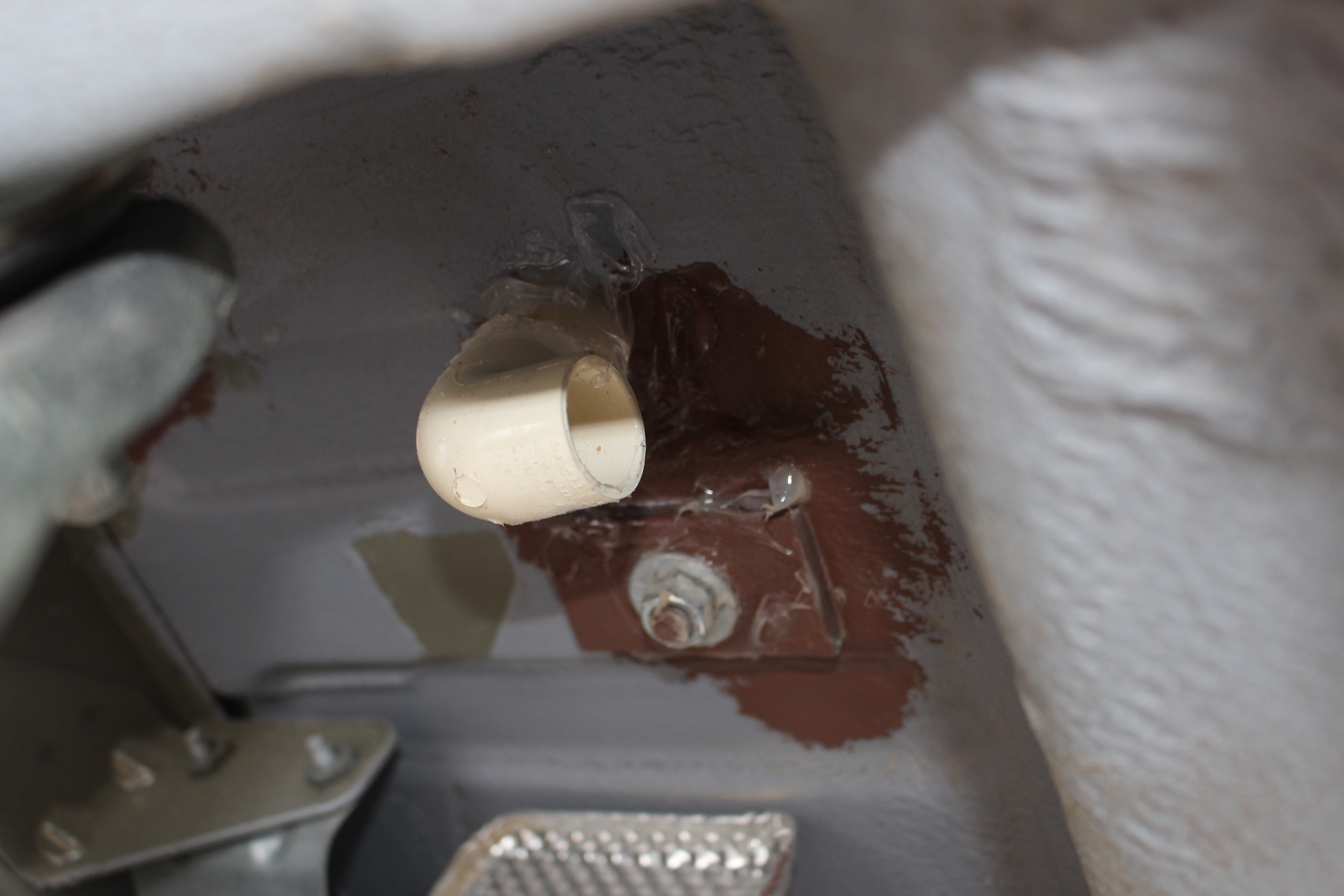
The outside end of the vent tube. Also visible is one of the bolts that hold the propane compartment in place.
Propane Plumbing
The regulator and hose arrangement is a standard BBQ style unit. It screws onto the cylinder by hand -- no tools required.
The rest of the propane plumbing is 3/8 inch flexible copper tubing with flare fittings used for the connections.
There is very little plumbing. A single 3/8 inch line runs forward from the tank along the drivers side near the van sidewall to a Tee that is located behind the furnace. One 3/8 copper line goes from the Tee to the furnace, and another goes from the other connection on the Tee to the propane stove.
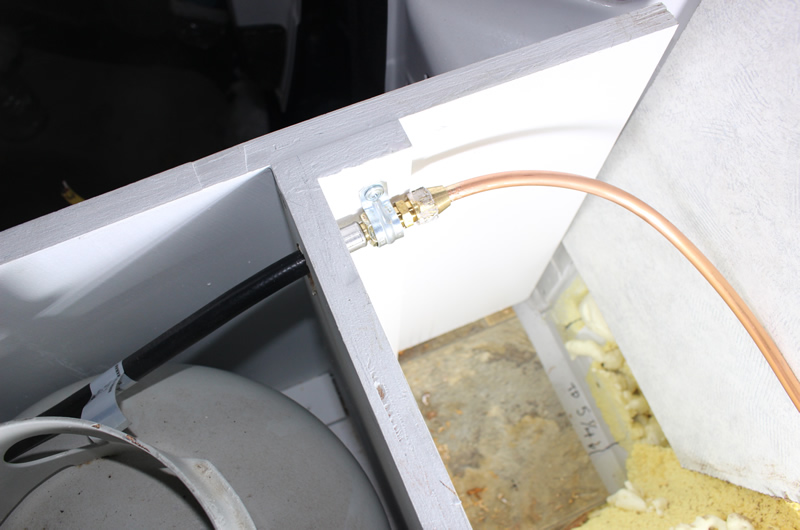
Connection of rubber hose from propane tank to the 3/8ths copper tubing.
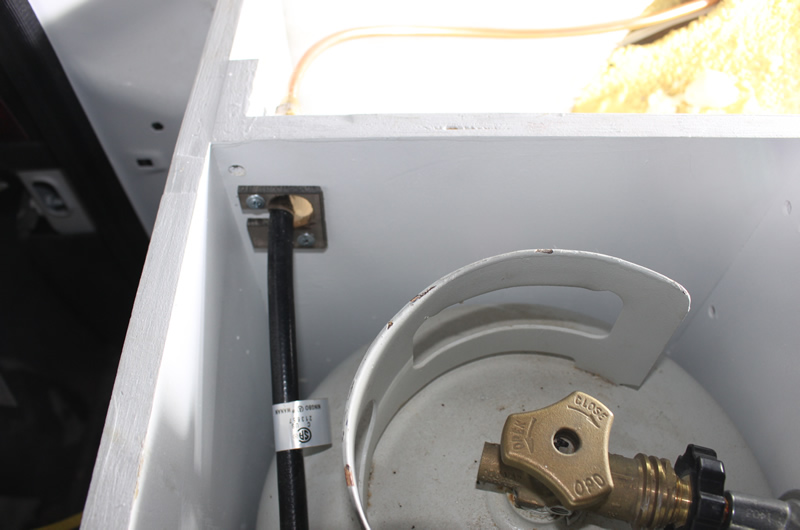
The sealing arrangement where the rubber tube leaves the propane tank compartment. A plastic "washer" and silicone seal.
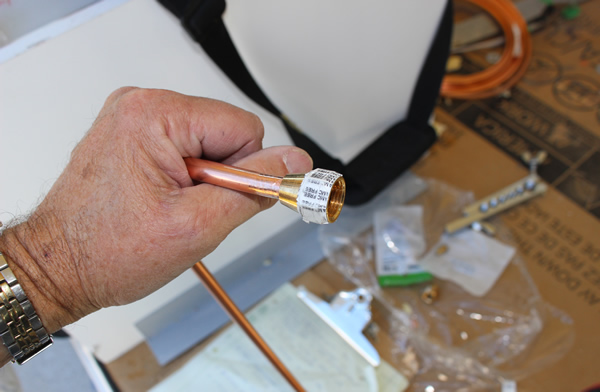
Flare fittings.
|
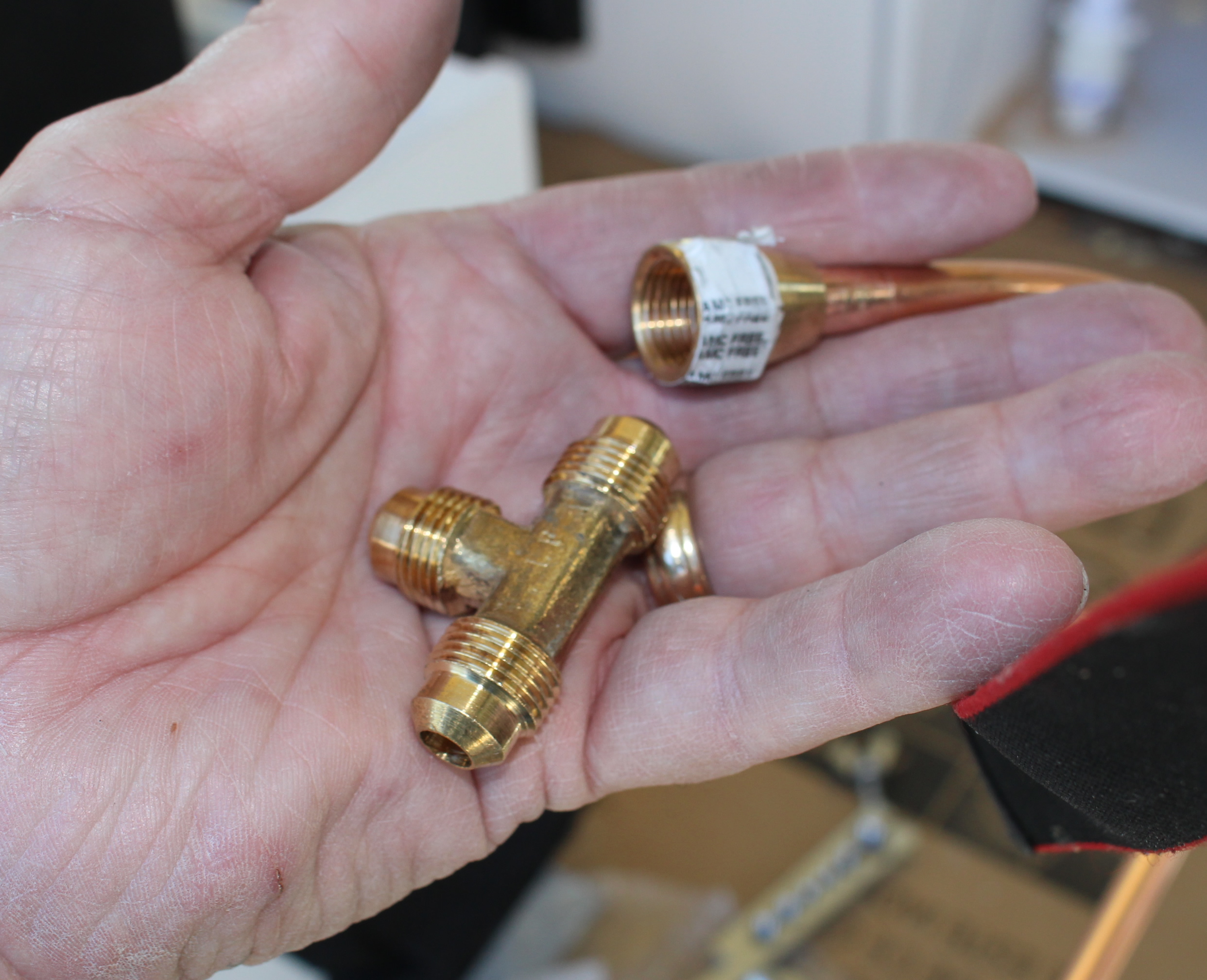 |
The flare fitting procedure is: 1) slide the flare nut onto the tubing 2) use the flare tool to flare the end of the gas line, 3) thread the flare nut onto the flare fitting.
This is the first time I have used the flare fittings, and they seem relatively easy to make up correctly, quite secure mechanically and gas tight.
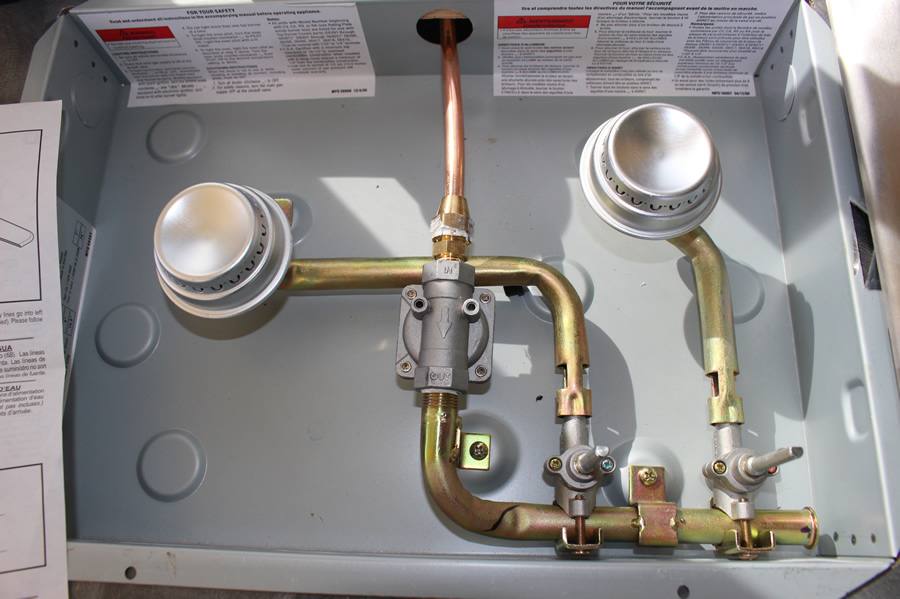
The 3/8 inch copper gas line coming into the propane stove.
Leaks
I checked all the connections with gas leak fluid -- no leaks.
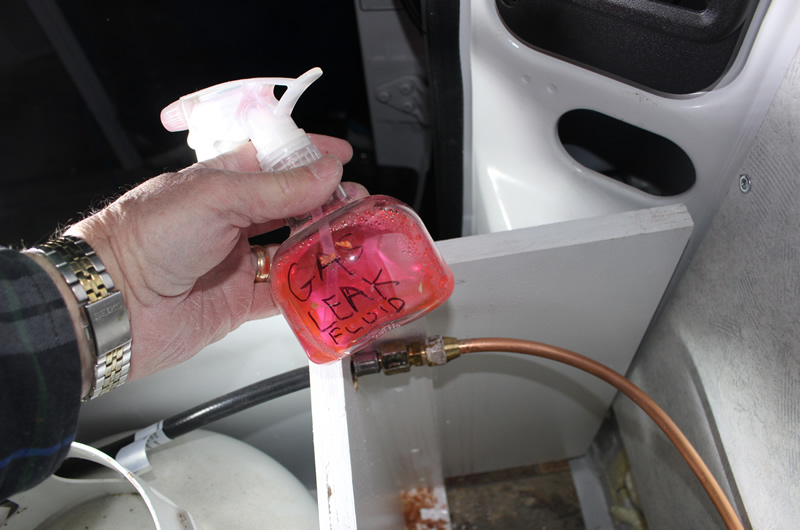
When to Refill?
I use a fish scale to measure how much propane is left in the cylinder -- an empty cylinder weighs about 17 lbs and a full cylinder is about 33 lbs. The weighing is done by hooking the scale on the loop of cord around the valve plumbing -- does not require removing the cylinder from the compartment or disconnecting the hose. A gauge of some sort would be handier, but have not had a chance to look for one.
Cost, Weight and Time
| Item |
Cost ($) |
Weight (lb) |
| 5 gallon propane cylinder |
$0 (on hand) |
17 empty, 33 full |
| 3/8 inch copper line and fittings |
$40? |
5 lb ? |
| Regulator and hose |
$20 |
3 lb? |
| |
|
|
| |
|
|
| Total |
$60 |
25 lb |
Installing the propane plumbing took a couple hours. The fabrication of the compartment for the propane tank is included in the Beds/Storage section.
We also installed a monitor in the RV living area that monitors for propane gas and for carbon monoxide -- this is covered in the Electrical section. Very important.
Comments
Comments and Suggestions...
Go back to the main camper van conversion page...
Gary
November 30, 2014
